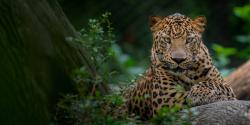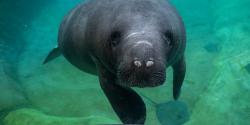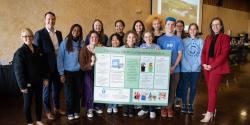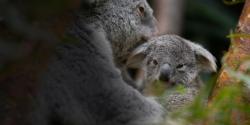Cumberland, OH – A fourth calf was born into The Wilds’ southern white rhinoceros herd during the afternoon hours of December 19. Born to mother, Eve—who was born at The Wilds in 2006—and father, Roscoe, this male calf helped The Wilds mark another milestone with the most calves born at the conservation center within a short span of approximately only 10 weeks. Additionally, he is celebrated as the 20th rhino to be born at The Wilds since 2004 and the 10th fourth-generation white rhino to be born at the facility. The Wilds is the only facility that has had fourth- and fifth-generation births of this species outside of Africa. Former Battelle President and CEO, Jeff Wadsworth, and his wife Jerre, selected the name “Gordon” for the calf with a nod to Gordon Battelle, the founder of the company which has generously supported The Wilds’ education programs.
Gordon’s arrival was preceded this season by the births of a female calf to mother, Anan, on October 5, a male born to mother, Zenzele, on November 16, and a male born to mother, Mustang Sally, on November 19. All four calves share the same father. The female calf has since been named “Faith” after one of The Wilds’ volunteers. Zenzele’s male calf received the name “Gilman” after the founder of The Howard Gilman Foundation, honoring the late Mr. Gilman’s generosity to The Wilds, and Sally’s calf was named “Tebogo” (a Botswanan name meaning “we are thankful”) by generous donors, Cy and Joanne Spurlino.
The Wilds staff has been monitoring all of the calves, who appear to be thriving under their mothers’ care. In addition to the white rhinos that have been born at The Wilds throughout its history, the conservation center has produced seven Asian one-horned rhinos. The breeding recommendations are part of the Association of Zoos and Aquariums’ (AZA) Species Survival Plan® (SSP) to enhance conservation of these species in their native range and to maintain a sustainable population of rhinos in human care.
This year, The Wilds also received “Top Honors” in the 2017 Edward H. Bean Award for the facility’s southern white rhinoceros program in September. The Edward H. Bean Award is a historic award within AZA, established in September 1956, honoring the first director of Chicago's Brookfield Zoo and one of the founders of AZA. The Edward H. Bean Award recognizes propagation or management programs that contribute to the reproductive success of one or more species and/or subspecies.
The white rhino population had dwindled to perhaps only 50-200 individuals at the beginning of the 20th century, but through conservation efforts, the population of white rhinos in their native African range has rebounded to about 20,400 animals. However, even with the increase in numbers, the species remains classified as near threatened by the International Union for Conservation of Nature (IUCN). All five remaining rhino species in Africa and Asia (white rhinoceros, black rhinoceros, greater one-horned rhinoceros, Javan rhinoceros, and Sumatran rhinoceros) are persecuted by poachers who sell rhino horn for ornamental or traditional medicinal purposes even though there are no scientifically proven health benefits for its use. The horns are made of keratin—the same substance that makes up fingernails and hair. The International Rhino Foundation, which receives support from The Wilds, estimates that one rhino is killed every eight hours for its horn.
White rhino calves are born after a gestation of 16 months and they can grow to be 4,000 pounds and six feet tall at their shoulder. Their natural habitats are plains or woodlands, interspersed with grassy openings. Through reintroduction efforts, their current range in the wild is in southern and eastern African countries.
Their physical characteristics are two pointed horns and a wide mouth suitable for grazing. The name white rhinoceros originated from the Afrikaans word describing the animal’s mouth – wyd, meaning “wide.” Early English settlers in South Africa misinterpreted the word wyd for “white.”
To further protect the future of rhinos, The Wilds and the Columbus Zoo has provided more than $196,000 in the last five years in support of conservation projects benefiting rhinos in their native ranges, such as monitoring black and white rhinos in Zimbabwe’s Lowveld region through the International Rhino Foundation and protecting black rhinos in the Ngulia Rhino Sanctuary in Kenya through the African Wildlife Foundation.
Those who are interested in seeing the four rhino calves before the spring can get a sneak peek of the young animals on special Winter at The Wilds tours. These tours offer unique perspectives and up-close animal encounters in several behind the scenes areas at The Wilds. For more information about Winter at The Wilds tours, please visit The Wilds’ website.
###
About The Wilds
The Wilds, one of the largest conservation centers in North America, is home to rare and endangered animals from around the world along with hundreds of indigenous species. The mission of The Wilds, a nonprofit organization, is to lead and inspire by connecting people and wildlife. The Wilds is located at 14000 International Road in Cumberland, Ohio, about 90 minutes east of Columbus. Normal hours of operation are 10 a.m. to 4 p.m. every day from May through September, and on Saturdays and Sundays in October. For more information, visit TheWilds.org.









